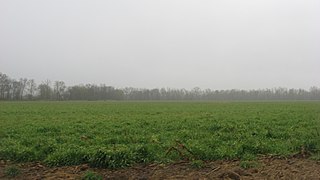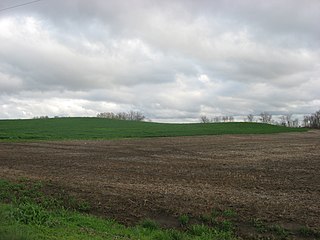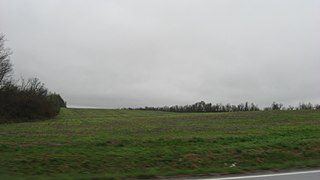Orendorf Site | |
| Location | Fulton County, Illinois |
|---|---|
| Nearest city | Canton |
| Coordinates | 40°29′15″N89°57′6″W / 40.48750°N 89.95167°W Coordinates: 40°29′15″N89°57′6″W / 40.48750°N 89.95167°W |
| Area | 40 acres (16 ha) |
| NRHP reference # | 77000484 [1] |
| Added to NRHP | September 13, 1977 |
The Orendorf Site is a prehistoric archaeological site located near the city of Canton, Fulton County, Illinois. The site includes four distinct areas of Middle Mississippian settlement; the settlement area was one of seven major sites in the Spoon River tradition. The four settlement sites within the larger site came as the result of a single village relocating multiple times; this movement became useful to archaeologists, as artifacts from different periods are spread out rather than mixed together at a single site. The settlement functioned as a regional center within the Spoon River culture, making it a hub in its hierarchal political organization and part of many important trade routes. Trade and migration linked the settlement to the large Mississippian city of Cahokia; while the settlement's culture had much in common with Cahokian culture, it was also a distinct regional culture in its own right. [2]

Canton is the largest city in Fulton County, Illinois, United States. The population was 14,704 at the 2010 census, down from 15,288 as of the 2000 census. The Canton Micropolitan Statistical Area covers all of Fulton County; it is in turn part of the wider Peoria-Canton, IL Combined Statistical Area (CSA).

Fulton County is a county in the U.S. state of Illinois. According to the 2010 census, it had a population of 37,069. Its county seat is Lewistown, and the largest city is Canton.

Illinois is a state in the Midwestern and Great Lakes region of the United States. It has the fifth largest gross domestic product (GDP), the sixth largest population, and the 25th largest land area of all U.S. states. Illinois is often noted as a microcosm of the entire United States. With Chicago in northeastern Illinois, small industrial cities and immense agricultural productivity in the north and center of the state, and natural resources such as coal, timber, and petroleum in the south, Illinois has a diverse economic base, and is a major transportation hub. Chicagoland, Chicago's metropolitan area, encompasses over 65% of the state's population. The Port of Chicago connects the state to international ports via two main routes: from the Great Lakes, via the Saint Lawrence Seaway, to the Atlantic Ocean and from the Great Lakes to the Mississippi River, via the Illinois Waterway to the Illinois River. The Mississippi River, the Ohio River, and the Wabash River form parts of the boundaries of Illinois. For decades, Chicago's O'Hare International Airport has been ranked as one of the world's busiest airports. Illinois has long had a reputation as a bellwether both in social and cultural terms and, through the 1980s, in politics.
The site was added to the National Register of Historic Places on September 13, 1977. [1] It is one of four sites on the Register in Canton, along with the Ulysses G. Orendorff House, the Parlin Library and the Chicago, Burlington & Quincy Railroad Station.

The National Register of Historic Places (NRHP) is the United States federal government's official list of districts, sites, buildings, structures, and objects deemed worthy of preservation for their historical significance. A property listed in the National Register, or located within a National Register Historic District, may qualify for tax incentives derived from the total value of expenses incurred preserving the property.

The Ulysses G. Orendorff House is a historic house located at 345 West Elm Street in Canton, Illinois. The house was built in 1902 for Ulysses G. Orendorff, the son of Parlin & Orendorff co-founder W. J. Orendorff; the company, the most successful in Canton, manufactured farming equipment and was later sold to International Harvester. Architect Robert C. Spencer of Chicago designed the house; Spencer was a friend of Frank Lloyd Wright and an early figure in the Prairie School, and the house represents Spencer's shift toward the Prairie School aesthetic from his earlier Tudor style works. Two large gables on the front of the house are decorated with a wooden grid with rows of windows and geometric patterns; while the design resembles half-timbering on its face, it embodies the horizontal emphasis that became a key feature of the Prairie School. The interior of the house is characteristic of the Prairie School, with natural materials and modern decorative elements.

The Parlin Library is a historic library building located at 210 East Chestnut Street in Canton, Illinois. The building was built in 1893-94 for the city's library; while the city had two library associations prior to then, both had failed and the city had no public library at the time. William Parlin, Sr., the founder of Canton's most prosperous business in the Parlin & Orendorff Company, bequeathed the money for the library in his estate when he died in 1890; his estate provided $8000 for the building and its collection, while an additional $5000 came from a library tax. The Peoria architectural firm of Richardson & Salter designed the Richardsonian Romanesque library. The library's collection included 1,000 books when it opened, a figure which increased to 8,000 by 1908; it also included a large art gallery. The library served in its original capacity until 1958, when a new library opened and the old building became Canton's city hall.




















